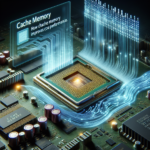The Role of CPUs in Smart Home Devices

The Role of CPUs in Smart Home Devices
Smart home devices have revolutionized the way we interact with our living spaces, offering unprecedented convenience, security, and efficiency. At the heart of these intelligent systems lies the Central Processing Unit (CPU), a critical component that drives the functionality and performance of smart home technology. This article delves into the role of CPUs in smart home devices, exploring their importance, functionality, and future trends.
Understanding CPUs in Smart Home Devices
What is a CPU?
The Central Processing Unit (CPU) is often referred to as the “brain” of a computer. It performs the essential task of executing instructions from software applications, processing data, and managing system resources. In the context of smart home devices, the CPU is responsible for handling various tasks, from simple command execution to complex data processing and communication with other devices.
Types of CPUs in Smart Home Devices
Smart home devices utilize different types of CPUs based on their specific requirements and functionalities. The most common types include:
- Microcontrollers (MCUs): These are compact, low-power CPUs designed for specific control tasks. They are commonly used in devices like smart thermostats, light bulbs, and door locks.
- System on Chip (SoC): SoCs integrate the CPU with other components like memory, input/output ports, and communication modules on a single chip. They are used in more complex devices like smart speakers, cameras, and home hubs.
- Application Processors: These are high-performance CPUs designed for running complex applications and operating systems. They are found in advanced smart home devices like smart TVs and home automation systems.
The Functionality of CPUs in Smart Home Devices
Data Processing and Execution
CPUs in smart home devices are responsible for processing data and executing commands. For instance, when a user adjusts the temperature on a smart thermostat, the CPU processes the input, retrieves the necessary data, and executes the command to adjust the heating or cooling system accordingly.
Communication and Connectivity
Smart home devices often need to communicate with each other and with external networks. The CPU manages these communication protocols, ensuring seamless connectivity. For example, a smart doorbell with a camera uses its CPU to process video data and transmit it to a user’s smartphone via Wi-Fi or Bluetooth.
Energy Efficiency
Energy efficiency is a critical consideration in smart home devices, especially those that run on batteries. CPUs play a vital role in optimizing power consumption by managing sleep modes, reducing processing power when not needed, and efficiently handling tasks to extend battery life.
Security and Privacy
With the increasing number of connected devices, security and privacy have become paramount. CPUs in smart home devices incorporate security features such as encryption, secure boot, and hardware-based authentication to protect user data and prevent unauthorized access.
Applications of CPUs in Smart Home Devices
Smart Lighting Systems
Smart lighting systems use CPUs to control various functions such as dimming, color changing, and scheduling. The CPU processes user inputs from mobile apps or voice commands and executes the desired lighting adjustments. Additionally, it manages communication with other smart home devices to create synchronized lighting scenes.
Smart Thermostats
Smart thermostats rely on CPUs to monitor and control home heating and cooling systems. The CPU processes data from temperature sensors, user inputs, and weather forecasts to optimize energy usage and maintain a comfortable indoor environment. Advanced models also use machine learning algorithms to learn user preferences and adjust settings automatically.
Smart Security Systems
CPUs in smart security systems handle tasks such as motion detection, video processing, and alarm management. For example, a smart security camera uses its CPU to analyze video feeds for suspicious activity and send alerts to the homeowner’s smartphone. The CPU also manages data encryption to ensure secure transmission and storage of video footage.
Smart Home Hubs
Smart home hubs act as central control units for various connected devices. The CPU in a smart home hub processes commands from users, manages communication between devices, and executes automation routines. It also integrates with voice assistants like Amazon Alexa or Google Assistant to provide voice control capabilities.
Future Trends in CPUs for Smart Home Devices
Edge Computing
Edge computing involves processing data closer to the source rather than relying on centralized cloud servers. This trend is gaining traction in smart home devices, as it reduces latency and enhances privacy. Future CPUs will be designed to handle more complex processing tasks locally, enabling faster response times and improved performance.
Artificial Intelligence and Machine Learning
Artificial Intelligence (AI) and Machine Learning (ML) are becoming integral to smart home devices. Future CPUs will incorporate specialized AI and ML accelerators to handle tasks such as voice recognition, image processing, and predictive analytics. This will enable smarter and more intuitive interactions with smart home systems.
Enhanced Security Features
As the number of connected devices continues to grow, so does the need for robust security measures. Future CPUs will integrate advanced security features such as hardware-based encryption, secure enclaves, and biometric authentication to protect user data and ensure the integrity of smart home systems.
Energy Efficiency Improvements
Energy efficiency will remain a key focus for future CPUs in smart home devices. Innovations in low-power design, dynamic voltage scaling, and power management techniques will enable longer battery life and reduced energy consumption, making smart home devices more sustainable and cost-effective.
FAQ
What is the role of a CPU in a smart home device?
The CPU in a smart home device is responsible for processing data, executing commands, managing communication protocols, optimizing energy consumption, and ensuring security. It acts as the brain of the device, enabling it to perform various functions and interact with other devices.
How do CPUs in smart home devices differ from those in traditional computers?
CPUs in smart home devices are often designed for specific tasks and optimized for low power consumption. They may be integrated into microcontrollers or System on Chip (SoC) architectures, whereas traditional computer CPUs are typically more powerful and designed for general-purpose computing.
Why is energy efficiency important for CPUs in smart home devices?
Many smart home devices run on batteries or have limited power sources. Energy-efficient CPUs help extend battery life and reduce overall energy consumption, making the devices more sustainable and cost-effective to operate.
What security features do CPUs in smart home devices offer?
CPUs in smart home devices incorporate various security features such as encryption, secure boot, hardware-based authentication, and secure enclaves. These features help protect user data, prevent unauthorized access, and ensure the integrity of the device.
How will future CPUs enhance the capabilities of smart home devices?
Future CPUs will incorporate advanced technologies such as edge computing, AI and ML accelerators, enhanced security features, and improved energy efficiency. These innovations will enable smarter, faster, and more secure interactions with smart home systems, enhancing overall user experience.
Conclusion
The role of CPUs in smart home devices is pivotal, driving the functionality, performance, and security of these intelligent systems. As technology continues to evolve, future CPUs will bring even more advanced capabilities, enabling smarter, more efficient, and secure smart home environments. Understanding the importance of CPUs in these devices helps us appreciate the complexity and potential of the smart home revolution.




